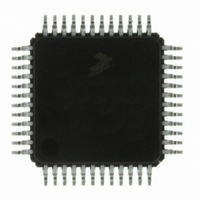MC9S08DZ60ACLF Freescale Semiconductor, MC9S08DZ60ACLF Datasheet - Page 122

MC9S08DZ60ACLF
Manufacturer Part Number
MC9S08DZ60ACLF
Description
IC MCU 60K FLASH 4K RAM 48-LQFP
Manufacturer
Freescale Semiconductor
Series
HCS08r
Datasheets
1.DEMO9S08DZ60.pdf
(416 pages)
2.EVB9S08DZ60.pdf
(4 pages)
3.MC9S08DZ48AMLF.pdf
(458 pages)
Specifications of MC9S08DZ60ACLF
Core Processor
HCS08
Core Size
8-Bit
Speed
40MHz
Connectivity
CAN, I²C, LIN, SCI, SPI
Peripherals
LVD, POR, PWM, WDT
Number Of I /o
39
Program Memory Size
60KB (60K x 8)
Program Memory Type
FLASH
Eeprom Size
2K x 8
Ram Size
4K x 8
Voltage - Supply (vcc/vdd)
2.7 V ~ 5.5 V
Data Converters
A/D 16x12b
Oscillator Type
External
Operating Temperature
-40°C ~ 85°C
Package / Case
48-LQFP
Processor Series
S08DZ
Core
HCS08
Data Bus Width
8 bit
Data Ram Size
4 KB
Interface Type
CAN, I2C, SCI, SPI
Maximum Clock Frequency
40 MHz
Number Of Programmable I/os
53
Number Of Timers
2
Operating Supply Voltage
5.5 V
Maximum Operating Temperature
+ 85 C
Mounting Style
SMD/SMT
3rd Party Development Tools
EWS08
Development Tools By Supplier
DEMO9S08DZ60
Minimum Operating Temperature
- 40 C
On-chip Adc
12 bit, 24 Channel
For Use With
DEMO9S08DZ60 - BOARD DEMOEVB9S08DZ60 - BOARD EVAL FOR 9S08DZ60
Lead Free Status / RoHS Status
Lead free / RoHS Compliant
Available stocks
Company
Part Number
Manufacturer
Quantity
Price
Company:
Part Number:
MC9S08DZ60ACLF
Manufacturer:
FREESCAL
Quantity:
1 250
Company:
Part Number:
MC9S08DZ60ACLF
Manufacturer:
Freescale Semiconductor
Quantity:
10 000
- Current page: 122 of 416
- Download datasheet (5Mb)
Chapter 7 Central Processor Unit (S08CPUV3)
interrupt service routine, this would allow nesting of interrupts (which is not recommended because it
leads to programs that are difficult to debug and maintain).
For compatibility with the earlier M68HC05 MCUs, the high-order half of the H:X index register pair (H)
is not saved on the stack as part of the interrupt sequence. The user must use a PSHH instruction at the
beginning of the service routine to save H and then use a PULH instruction just before the RTI that ends
the interrupt service routine. It is not necessary to save H if you are certain that the interrupt service routine
does not use any instructions or auto-increment addressing modes that might change the value of H.
The software interrupt (SWI) instruction is like a hardware interrupt except that it is not masked by the
global I bit in the CCR and it is associated with an instruction opcode within the program so it is not
asynchronous to program execution.
7.4.3
The WAIT instruction enables interrupts by clearing the I bit in the CCR. It then halts the clocks to the
CPU to reduce overall power consumption while the CPU is waiting for the interrupt or reset event that
will wake the CPU from wait mode. When an interrupt or reset event occurs, the CPU clocks will resume
and the interrupt or reset event will be processed normally.
If a serial BACKGROUND command is issued to the MCU through the background debug interface while
the CPU is in wait mode, CPU clocks will resume and the CPU will enter active background mode where
other serial background commands can be processed. This ensures that a host development system can still
gain access to a target MCU even if it is in wait mode.
7.4.4
Usually, all system clocks, including the crystal oscillator (when used), are halted during stop mode to
minimize power consumption. In such systems, external circuitry is needed to control the time spent in
stop mode and to issue a signal to wake up the target MCU when it is time to resume processing. Unlike
the earlier M68HC05 and M68HC08 MCUs, the HCS08 can be configured to keep a minimum set of
clocks running in stop mode. This optionally allows an internal periodic signal to wake the target MCU
from stop mode.
When a host debug system is connected to the background debug pin (BKGD) and the ENBDM control
bit has been set by a serial command through the background interface (or because the MCU was reset into
active background mode), the oscillator is forced to remain active when the MCU enters stop mode. In this
case, if a serial BACKGROUND command is issued to the MCU through the background debug interface
while the CPU is in stop mode, CPU clocks will resume and the CPU will enter active background mode
where other serial background commands can be processed. This ensures that a host development system
can still gain access to a target MCU even if it is in stop mode.
Recovery from stop mode depends on the particular HCS08 and whether the oscillator was stopped in stop
mode. Refer to the
122
Wait Mode Operation
Stop Mode Operation
Modes of Operation
MC9S08DZ60 Series Data Sheet, Rev. 4
chapter for more details.
Freescale Semiconductor
Related parts for MC9S08DZ60ACLF
Image
Part Number
Description
Manufacturer
Datasheet
Request
R
Part Number:
Description:
Manufacturer:
Freescale Semiconductor, Inc
Datasheet:
Part Number:
Description:
Manufacturer:
Freescale Semiconductor, Inc
Datasheet:
Part Number:
Description:
Manufacturer:
Freescale Semiconductor, Inc
Datasheet:
Part Number:
Description:
Manufacturer:
Freescale Semiconductor, Inc
Datasheet:
Part Number:
Description:
Manufacturer:
Freescale Semiconductor, Inc
Datasheet:
Part Number:
Description:
Manufacturer:
Freescale Semiconductor, Inc
Datasheet:
Part Number:
Description:
Manufacturer:
Freescale Semiconductor, Inc
Datasheet:
Part Number:
Description:
Manufacturer:
Freescale Semiconductor, Inc
Datasheet:
Part Number:
Description:
Manufacturer:
Freescale Semiconductor, Inc
Datasheet:
Part Number:
Description:
Manufacturer:
Freescale Semiconductor, Inc
Datasheet:
Part Number:
Description:
Manufacturer:
Freescale Semiconductor, Inc
Datasheet:
Part Number:
Description:
Manufacturer:
Freescale Semiconductor, Inc
Datasheet:
Part Number:
Description:
Manufacturer:
Freescale Semiconductor, Inc
Datasheet:
Part Number:
Description:
Manufacturer:
Freescale Semiconductor, Inc
Datasheet:
Part Number:
Description:
Manufacturer:
Freescale Semiconductor, Inc
Datasheet:











